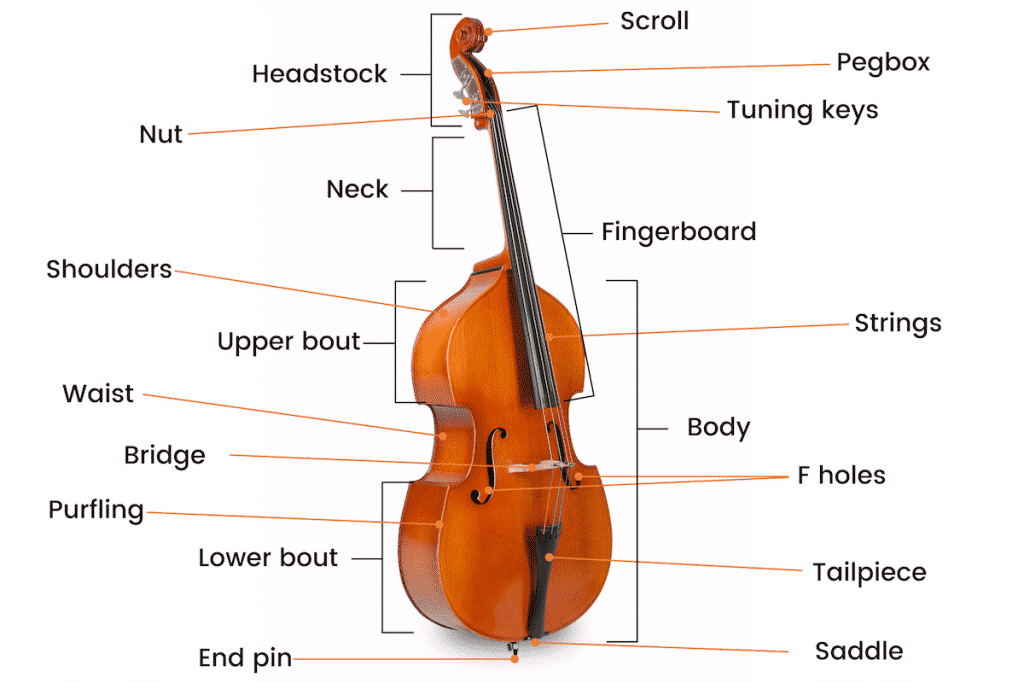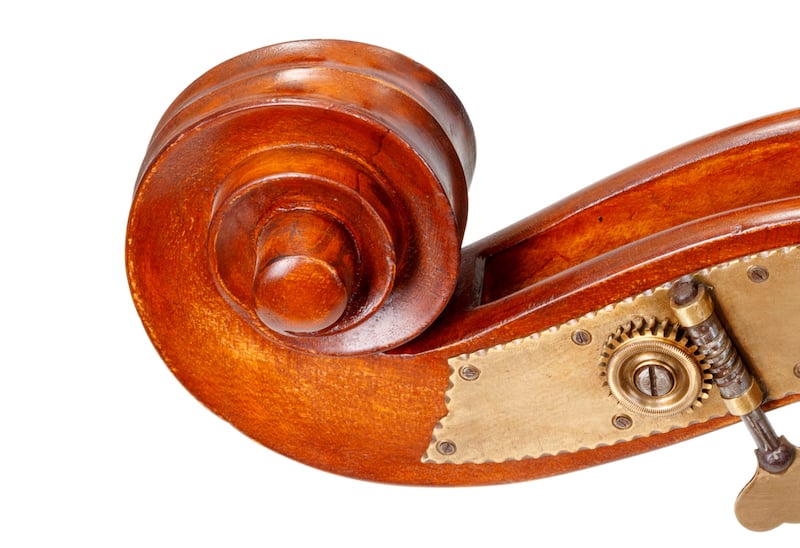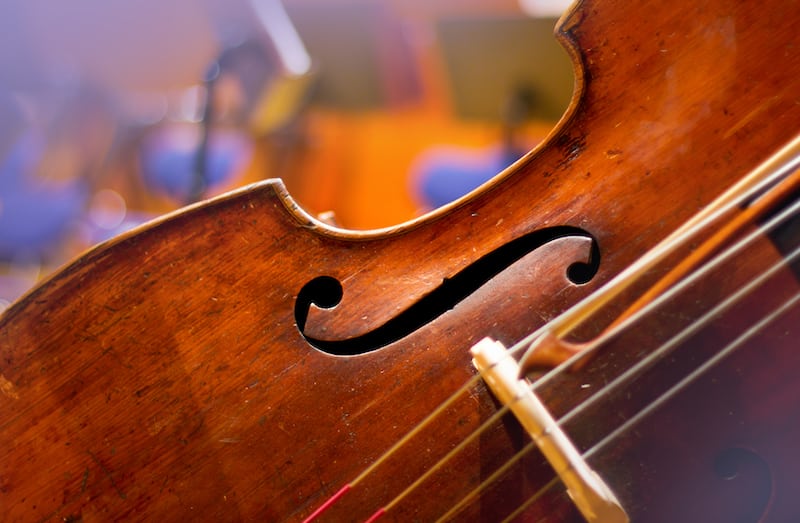The double bass is an irreplaceable sound system whose heavy, rhythmic power and lush rumble are a delight to many. Whether you’re playing jazz, pop, rock, classical, or country music, the double bass is designed to produce broad, timber-dark notes and deep reverberations that are more incisive.
In this guide, we’re going to take you through all the parts of double bass that students need to know, their features, and the role each part plays in creating the low and beautiful sound of this great instrument.
The Anatomy of a Double Bass

Like most stringed instruments, the double bass has three main parts:
- headstock
- neck
- body
Each of these larger parts is then subdivided into smaller elements that play distinct roles to create the sound and allow you to play the double bass.
Let’s dive into each part and look at the role they play.
The Headstock

The double bass’ headstock is the very end and top of the bass.
It’s where the strings originate and is the part they’re tied to in order to create tension that allows them to be played.
In the headstock, you’ll find the:
- Scroll
- Pegbox
- Tuning Pegs
Let’s take a look at each of these parts and find out their roles.
The Scroll

The scroll is a piece of wood that’s carved into the topmost part of the headstock.
It comes in a volute (rolled-up spiral) shape, but you can also find rare designs such as human faces, animals, and gargoyles.
The scroll is the maker’s artistry to decorate the double bass to give it a more appealing, traditional aesthetic.
However, in some basses, the scroll adds weight to the headstock which can help to make the wolf tones (overtones of the bass’ natural frequency) to fade or disappear completely.
Pegbox
The pegbox contains all the mechanisms that the strings wrap around to keep them tight enough to be able to create the different pitches when you play.
All the strings are tied here and then travel down across the fingerboard and bridge all the way down to the tailpiece.
Tuning Pegs (Keys)
The tuning pegs are the part of the double bass that you turn to tune the bass’ strings.
It’s essentially a knob that holds the strings and makes sure you can easily adjust their tension by turning them which either tightens the string (which raises the pitch) or loosens the string (which lowers the pitch).
The Neck
Next, we have the neck which is the part of the double bass that joins the headstock with the body of the bass.
Double bass necks are typically made out of maple wood and consist of the nut, the strings, and the fingerboard.
The Nut
The nut on a double bass is a small piece of wood in between the neck and the headstock.
Typically made out of ebony, the nut keeps the strings spaced apart and also determines the action – how high the strings are off the fingerboard.
The Fingerboard

The fingerboard on a double bass is the thin piece of wood (usually ebony but sometimes rosewood) that sits on top of the neck and extends over the body of the bass.
The fingerboard plays a vital role as it is the part that musicians press down on with their fingers to produce different pitches – which is where it gets its name from.
When you press a string down on the fingerboard, you shorten the length of the double bass’ string which changes the pitch.
The Strings
Most double basses have four strings that attach to the tuning peg on the head and extend to the tail.
These strings are tuned to the notes E-A-D-G with E being the lowest pitch and G the highest.
Although they’re called strings, they are not actually made of string and nowadays are made out of metal or gut.
The reason they’re called gut strings is that they used to literally be made out of animal intestines.
The strings can be played with a bow (arco) or plucked with fingers (pizzicato) which causes the string to vibrate at different pitches depending on the length and tension of the string.
The musician can push down the string at different places on the fingerboard which causes the string’s length to change which in turn changes the pitch.
The Body
The biggest part of an upright bass is the body, which is the large soundbox made out of wood.
When you play a string, the vibrations are transferred through the bridge to the body which resonates and produces the notes.
You can even feel the wood of the body vibrate if you touch it when its played!
The body is made up of 3 pieces of wood: the top, the back and the ribs as well as lots of other parts which we’ll look at now.
The Top, Back and Ribs
The body of a double bass is made up of three pieces of wood, the top and back, which are then held together by the ribs.
The top and back are made out of wood, typically spruce, but some basses are also made out of plywood, beech, pine and cedar.
When the string is plucked, the vibrations travel through the bridge to the top which vibrates and amplifies the sound.
The top also has F holes cut into it to help develop the tone of the sound and also increase the volume.
The ribs on a double bass connect the top with the back and help to create a resonance chamber.
Like the neck, the ribs are usually made out of maple.
F-holes

The F-holes (also called sound holes) are the letter F-shaped holes in the top of the body.
They act as passageways for the sound to escape the cavity of the bass and help to amplify its sound and tone by allowing the instrument to resonate more.
Whenever you manipulate the length of an F-hole, the sound also changes, affecting the overall harmony and tone of the instrument.
You’ll see these F-holes on all sorts of stringed instruments like the violin, viola, cello, and even some types of guitars.
The Bridge

The bridge is the small arch-like piece of wood that holds up the strings as they pass over the body of the bass.
Like the nut, its job is to keep the strings separated and it also determines how much the action is (the distance of the strings to the fretboard.
It also helps to transfer the vibrations of the strings to the body of the bass which creates the sound.
Although it looks and feels like it’s attached to the body, the bridge is only held up by the tension of the strings and if you were to loosen the strings too much it would fall over.
Purfling
Purfling refers to the narrow decorative edge around the top and back of a double bass.
The main role of the purfling is to enhance the aesthetics of the instrument, but, it also prevents the edges from cracking, especially due to wear and tear and changes in temperature and humidity.
It’s made using two or three strips of wood with a lighter wood used in between two darker ones.
You can also see purfling painted to further customize the look.
Soundpost
Inside the body of a double bass, you’ll find a soundpost which is a small piece of wood that is placed in between the front and the back of the body.
It’s very important as it helps the vibrations to travel between the top and back plates.
It’s also held up by the tension of the bridge pushing down.
It’s important when changing strings on a double bass to not take them off at the same time as it can cause the sound post to fall over.
If it does, the sound of the bass will completely change and you’ll need to visit a luthier to put it back up.
Tailpiece
Towards the bottom of a double bass, you’ll find the tailpiece which is a thing piece of wood (usually ebony).
It has four small holes cut into it which is where the strings are inserted and anchors them at the opposite end to the pegbox.
This creates tension which allows the strings to produce different pitches of notes.
Unlike other string instruments like, the violin or the cello, a double bass doesn’t have fine tuners on the tailpiece and it can only be tuned by using the tuning pegs at the other end.
The Endpin (Spike)
The endpin or spike is the bottommost part of the double bass, located just a few inches below the tailpiece.
The main function of an endpin is to provide contact with the floor and hold the bass in place while you’re playing it.
It’s usually made of metal and has a spike at the end of it but most basses nowadays have a rubber tip on the end to provide friction and grip with the floor (and not damage it).
You can increase and decrease the length of the endpin so that you can adjust the bass’ height to your preference so that it’s comfortable to play.
Summing up the Double Bass Parts
As you can see, double basses are complex instruments that require a lot of work to make and each one is completely unique.
We hope that this guide to the different double bass parts has helped explain each piece’s role in a bit more detail.
If you have any further questions just let us know!
